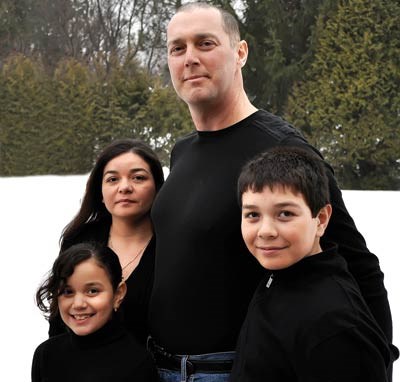Watching the steady flow of people who turned up at the New Sudbury Centre to sign up as a potential stem cell donor was a “very emotional” experience for Mariolen Hagen.
She said she was touched so many people want to help her husband, Jason Hagen, who has been diagnosed with Acute Myeloid Leukemia, a fast-growing cancer of the blood and bone marrow.
Jason, who was diagnosed in October of last year, requires a stem cell donation as a way to treat his condition. The unrelated stem cells will stimulate his body to begin producing cancer-free stem cells and bone marrow.
Nobody in his family is a suitable donor, as is the case of 70 per cent of those who require stem cell donations.
In an attempt to find such a donor, OneMatch, the stem cell and bone marrow network in Canada, held an information session at the Sudbury mall March 15.
Nearly 600 people between the ages of 17 and 50 had the insides of their mouths swabbed.
Their DNA will be checked to see if they are a match for Jason or somebody else who needs a stem cell donation.
“We just try to focus on the positive, and keep hopeful that there is somebody out there to match Jason,” Mariolen said.
“There are other patients out there that we've met. It certainly tears at your heart. If this finds a match for somebody else that you know is going through the same thing, it's really, really important.”
There are currently 849 patients in Canada who could benefit from finding a match.
Mariolen said the response was so overwhelming that OneMatch actually ran out of swabbing kits during the last hour they were set up in the mall.
Many of the potential donors were Mariolen's co-workers at Mining Technologies International and Jason's colleagues at Vale, but some were also strangers who showed up at the donation drive after hearing about it through the media.
Those who were unable to be screened as a donor at the mall are asked to go to www.onematch.ca, and fill out a registration form. A swabbing kit will then be sent to the potential donor through the mail.
How Donation Works
Bone Marrow Stem Cells
If a donor makes a bone marrow donation, he or she is given either a general or regional anesthetic. A special needle is inserted into the iliac crest (hip bone) and the marrow is extracted (the amount of marrow taken ranges from 500 to 1500 millilitres). The marrow will then replenish itself within approximately three weeks.
Peripheral Blood Stem Cells
For a peripheral blood stem cell donation, a donor receives injections of a granulocyte colony stimulating factor (G-CSF) for a minimum of four days. These injections increase the number of stem cells found in the blood. To collect these cells, the donor is connected to an apheresis machine with a needle. Blood is drawn through a tube into a centrifuge and there the stem cells are collected and the remaining blood components are returned to the donor through another needle.
What Happens After Donation
Once the donation is complete, a medical courier transports the stem cells to the transplant centre. Each method of stem collection has side effects and risks, which are explained to the donor before he or she makes the decision to donate.
After the donation is made, a nurse will continue to monitor the donor’s health to ensure the donor completely recovers.
Source: onematch.ca
